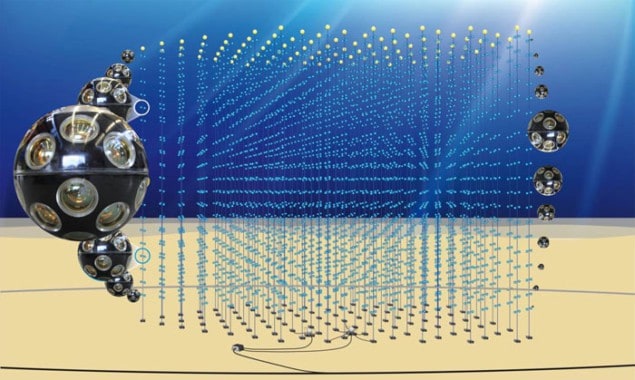
A consortium of European physicists building a vast neutrino detector on the floor of the Mediterranean Sea has unveiled the science it will carry out. The Cubic Kilometre Neutrino Telescope (KM3NeT) will use strings of radiation detectors arranged in a 3D network to measure the light emitted when neutrinos very occasionally interact with the surrounding sea water. The details were revealed last week in a “letter of intent” in the Journal of Physics G: Nuclear and Particle Physics (published by IOP Publishing, which also publishes physicsworld.com). The collaboration says that the energy and direction of the detected neutrinos will be used to carry out astronomy and to improve our understanding of neutrinos themselves.
First proposed in 2004, the telescope was originally designed to be built at a single location. But disagreements among the project’s partner countries delayed the facility by several years. The new plan will see it spread out over two, and eventually perhaps three, different sites. The telescope, which was supposed to have been switched on in 2014 to let it take data alongside the US IceCube neutrino observatory at the South Pole, will now not become fully operational until 2020 at the earliest.
Telescopic trio
The new plan splits KM3NeT into “building blocks”, each of which consists of 115 strings. Along the strings will be 18 optical modules, each made from 31 photomultiplier tubes. Two of these building blocks will be assembled about 3.5 km underwater, some 100 km from the south-eastern tip of Sicily. Researchers hope to use them to confirm the 2013 discovery by IceCube of neutrinos originating from deep space and pinpoint the sources of those neutrinos. The Italian facility should become more sensitive than the Antarctic observatory about a year after coming online, according to KM3NeT spokesman Maarten de Jong of Leiden University and the National Institute for Nuclear Physics and High Energy Physics in Amsterdam. “The weak interaction between neutrinos and normal matter is a blessing and curse,” says de Jong, adding that “it makes detecting them notoriously difficult, which is why you need a giant detector”.
The third building block, meanwhile, will be assembled about 40 km offshore from Toulon in southern France, close to KM3NeT’s forerunner telescope ANTARES (a 12-string array based off the coast of France). The main aim here is to study the “mass hierarchy” of neutrino flavours, which is important in understanding matter/antimatter asymmetry. Assuming it is built on schedule, KM3NeT should reveal this hierarchy in about 2023, says de Jong, putting it ahead of rival experiments.
Building up
So far the KM3NeT consortium has received €31m to develop and test its detector technology, as well as to install 31 strings by the end of next year – the first string having already turned on in December 2015. According to de Jong, the additional €95m needed to complete the three building blocks, which will probably come largely from the EU, should be secured by the end of this year, enabling it to start up in 2020 as planned. He says that the completed observatory will be about twice as big but cost half as much as the original design because it will incorporate many photomultiplier tubes inside a single detector module.
Ultimately, de Jong and colleagues hope to expand KM3NeT so that it consists of seven building blocks, one or more of which might be built off the coast of Greece. Not only would that be attractive politically as a stimulus to Greece’s economy, he says, it would also make the telescope more sensitive to sources of neutrinos within our own galaxy.
IceCube principal investigator Francis Halzen of the University of Wisconsin–Madison describes himself as “a great fan” of KM3NeT, arguing that building a neutrino telescope in stages is “certainly reasonable”. Doing so, he says, means being able to “adjust the detector configuration depending on experience with operations and on scientific results”.
The letter is published in the Journal of Physics G: Nuclear and Particle Physics.



